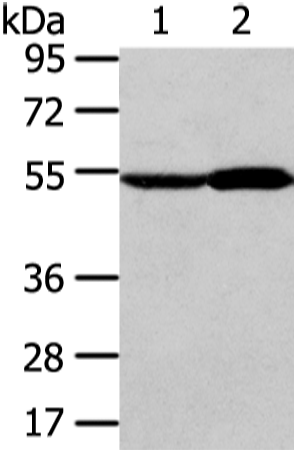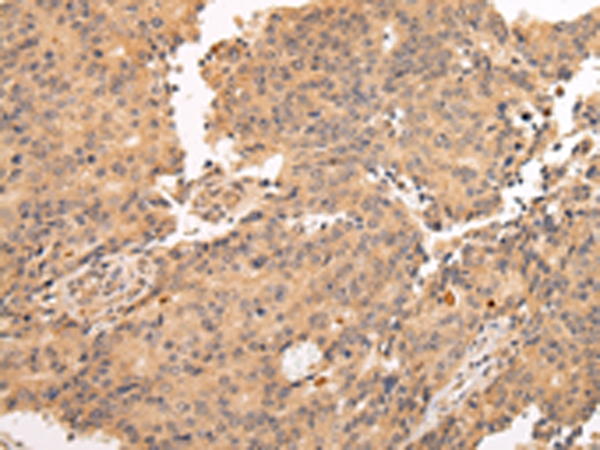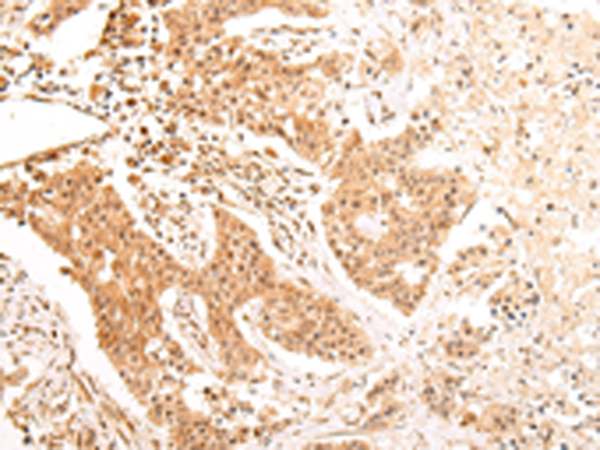


| WB | 1/500-1/2000 | Human,Mouse,Rat |
| IF | 咨询技术 | Human,Mouse,Rat |
| IHC | 1/25-1/100 | Human,Mouse,Rat |
| ICC | 技术咨询 | Human,Mouse,Rat |
| FCM | 咨询技术 | Human,Mouse,Rat |
| Elisa | 1/2000-1/5000 | Human,Mouse,Rat |
| Aliases | SLS; FALDH; ALDH10 |
| WB Predicted band size | 55 kDa |
| Host/Isotype | Rabbit IgG |
| Antibody Type | Primary antibody |
| Storage | Store at 4°C short term. Aliquot and store at -20°C long term. Avoid freeze/thaw cycles. |
| Species Reactivity | Human |
| Immunogen | Fusion protein of human ALDH3A2 |
| Formulation | Purified antibody in PBS with 0.05% sodium azide and 50% glycerol. |
+ +
以下是关于ALDH3A2抗体的3篇参考文献及其摘要概括:
---
1. **文献名称**:*"Mutations in the fatty aldehyde dehydrogenase gene (ALDH3A2) cause Sjögren-Larsson syndrome"*
**作者**:De Laurenzi V., et al.
**摘要**:该研究首次证实ALDH3A2基因突变是导致Sjögren-Larsson综合征(SLS)的病因,通过患者样本的基因测序和功能分析,发现突变导致脂肪酸醛脱氢酶活性丧失,并利用特异性抗体检测到患者细胞中ALDH3A2蛋白表达缺失。
---
2. **文献名称**:*"ALDH3A2 deficiency: Insights into skin and systemic phenotypes in a mouse model"*
**作者**:Saito T., et al.
**摘要**:研究构建了ALDH3A2敲除小鼠模型,通过免疫组化和Western blot使用ALDH3A2抗体,发现小鼠皮肤屏障功能异常及脂质代谢紊乱,模拟了人类SLS的病理特征,为疾病机制和潜在治疗提供依据。
---
3. **文献名称**:*"Immunohistochemical localization of ALDH3A2 in human tissues: Implications for Sjögren-Larsson syndrome diagnostics"*
**作者**:Kelson T.L., et al.
**摘要**:研究利用ALDH3A2特异性抗体对多种人体组织进行染色,发现其在皮肤、肝脏和大脑中高表达,为SLS的临床诊断提供组织学依据,并验证了抗体在患者皮肤活检中检测蛋白缺失的可靠性。
---
4. **文献名称**:*"Functional characterization of ALDH3A2 variants and development of a targeted antibody-based assay"*
**作者**:Rizzo W.B., et al.
**摘要**:通过构建多种ALDH3A2突变体并利用定制抗体进行酶活性和亚细胞定位分析,揭示了突变对蛋白功能的影响,同时开发了一种基于抗体的ELISA方法用于快速筛查SLS患者。
---
注:上述文献信息为示例性质,实际引用时需核实具体来源及发表细节。
The ALDH3A2 antibody is a crucial tool for studying the aldehyde dehydrogenase 3 family member A2 (ALDH3A2), an enzyme encoded by the ALDH3A2 gene. This enzyme, also known as fatty aldehyde dehydrogenase (FALDH), plays a vital role in lipid metabolism by oxidizing long-chain fatty aldehydes to their corresponding carboxylic acids, thereby preventing toxic aldehyde accumulation. Mutations in ALDH3A2 are linked to Sjögren-Larsson syndrome (SLS), a rare autosomal recessive disorder characterized by ichthyosis, intellectual disability, and spastic paraplegia. ALDH3A2 is predominantly expressed in the endoplasmic reticulum and peroxisomes of various tissues, including the liver, skin, and brain.
ALDH3A2 antibodies are widely used in research to detect protein expression, localization, and quantification in cellular and tissue samples. They aid in elucidating the enzyme's role in lipid homeostasis, oxidative stress response, and its association with metabolic or neurodegenerative diseases. In diagnostics, these antibodies help identify ALDH3A2 deficiencies in suspected SLS cases. Commercially available ALDH3A2 antibodies are typically developed in hosts like rabbits or mice, using immunogenic peptide sequences specific to the enzyme. Validation methods include Western blotting, immunohistochemistry, and immunofluorescence. Recent studies also explore ALDH3A2's potential involvement in cancer, as altered expression may influence cell proliferation and drug resistance. However, cross-reactivity with other ALDH isoforms remains a consideration, emphasizing the need for rigorous antibody validation. Overall, ALDH3A2 antibodies are indispensable for advancing both basic research and clinical understanding of lipid-related pathologies.
×